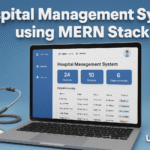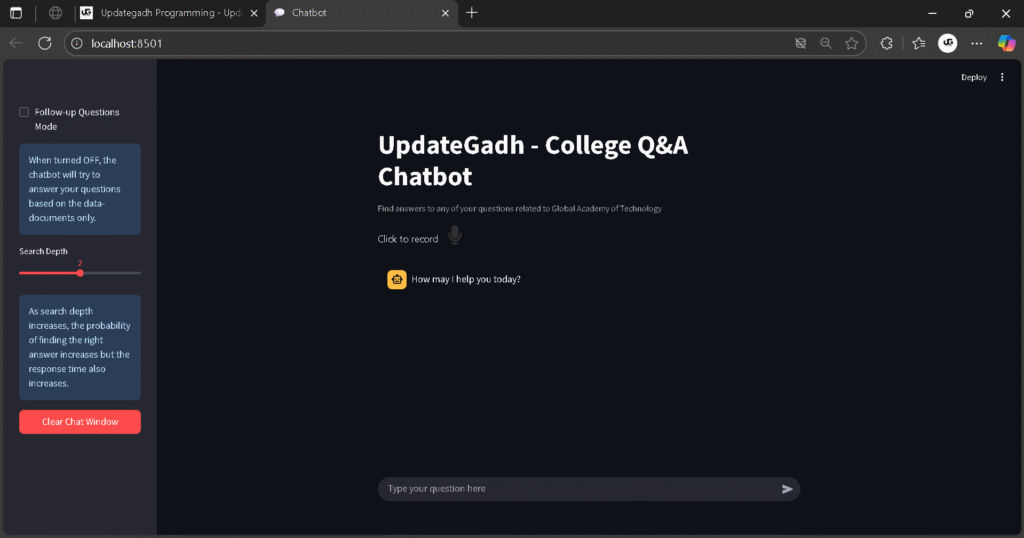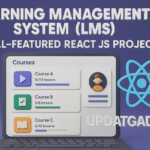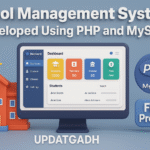
Best College Q&A Chatbot Using Python, LLMs, RAG, and Streamlit
College Q&A Chatbot Using Python, LLMs, RAG, and Streamlit
Managing college-related queries is often a challenge for students, faculty, and newcomers. To solve this, a College Q&A Chatbot was developed — a smart, context-aware assistant designed specifically for the Global Academy of Technology (GAT). This chatbot leverages Large Language Models (LLMs), Text Embeddings, and Retrieval-Augmented Generation (RAG) to provide accurate and context-rich answers. With its ability to accept both text and audio inputs, the chatbot ensures a smooth and interactive experience.
As a student who explored and worked with this project, I found it highly relevant not only for academic institutions but also as a great learning tool for anyone interested in AI, natural language processing, and application development.
Download New Real Time Projects :-Click here
Project Overview
| Attribute | Details |
|---|---|
| Project Name | College Q&A Chatbot |
| Language/s Used | Python |
| Database | Preloaded Text Files with Embeddings (Pickle Storage) |
| Type | Desktop/Web Application (Streamlit-based) |
Available Features
The chatbot comes with several practical features that make it both powerful and user-friendly:
- Text and Audio Input: Users can type queries or record voice inputs for responses.
- Retrieval-Augmented Generation (RAG): Pulls accurate answers from preloaded documents related to GAT.
- Context-Aware Responses: Maintains conversation history for coherent and contextually meaningful answers.
- Streamlit Interface: Clean, interactive interface with options for follow-up mode and search depth customization.
Installation Guide (VS Code)
To run this project smoothly in Visual Studio Code, follow the steps below:
1. Clone or Extract Project Files
Download or extract the project folder and open it in VS Code.
2. Create a Virtual Environment
Open a terminal in VS Code and run:
python -m venv venv
Activate the environment:
- On Windows:
venv\Scripts\activate
- On Linux/Mac:
source venv/bin/activate
3. Install Dependencies
Once the environment is active, install the required libraries:
pip install -r requirements.txt
4. Configure API Key
Create a file named config.json in the root directory and add your Google API key:
{
"google_api_key": "YOUR_GOOGLE_API_KEY"
}
5. Run the Application
Finally, start the chatbot with:
streamlit run st_app.py
Usage
The chatbot is designed to serve students, faculty, and administrators with accurate information about the Global Academy of Technology. Here’s how different types of users can interact with it:
- Students: Ask questions about courses, facilities, faculty, events, or general academic queries. They can use either text or voice input.
- Faculty: Get quick access to details about departments, academic schedules, and resources without navigating lengthy documents.
- Newcomers/Parents: Use the chatbot to find admission-related information, fee structures, or campus details.
The interface provides:
- Follow-Up Mode: Maintains conversation history to answer related questions in context.
- Search Depth Control: Adjusts how deeply the bot searches in preloaded documents for precise answers.
Project Structure
The project is well-organized with dedicated scripts and data files:
- st_app.py – The main application file for running the chatbot.
- embeddings_generator.py – Script to generate embeddings from text data.
- data_generation/gat_raw.txt – Raw scraped content from GAT-related sources.
- data_generation/gat_refined.txt – Human-refined dataset for better accuracy.
- gat_embeddings.pkl – Precomputed embeddings stored for faster response.
- config.json – Stores API key configuration.
- requirements.txt – Contains the Python dependencies list.
Generating Data and Embeddings
The chatbot’s intelligence relies on properly structured data and embeddings.
- Data Preparation:
- Use
web_scrapper.ipynbto scrape text data from websites. - Save results into
gat_raw.txt. - Refine content manually and store it in
gat_refined.txt.
- Use
- Generating Embeddings:
Run the following command to generate embeddings:python embeddings_generator.py --data_file data_generation/gat_refined.txtThis creates agat_embeddings.pklfile, which the chatbot uses to answer questions effectively.
Contributing
If you wish to improve this project, here are the guidelines:
- Fork the project and create a new branch for your changes.
- Ensure that your code is clean, properly commented, and tested.
- Follow Python’s PEP 8 standards for coding style.
- Submit a pull request with a clear explanation of the modifications.
License
This project is licensed under the terms mentioned in the LICENSE file provided within the project folder. Make sure to review it before reusing or distributing the code.
Final Thoughts
From a student’s perspective, the College Q&A Chatbot is not only an exciting academic project but also a glimpse into how modern AI can transform institutional communication. Instead of browsing through lengthy documents or waiting for responses, users can get instant answers tailored to their queries.
Working on this project deepened my understanding of LLMs, embeddings, RAG pipelines, and Streamlit deployment. More importantly, it highlighted how practical AI applications can solve real-world challenges in education.
This chatbot stands as a bridge between raw institutional data and meaningful, user-friendly access — making it a valuable resource for students, faculty, and administrators alike.
We have projects Available in all languages:–Click Here

chatbot using python source code
chatbot using python github
chatbot project in python pdf
chatbot in python code
python chatbot code copy and paste
end to end chatbot using python
create chatbot using python nlp
ai-chatbot python github
chatgpt
google colab
chatbot
langchain
free chatbot using python










Post Comment